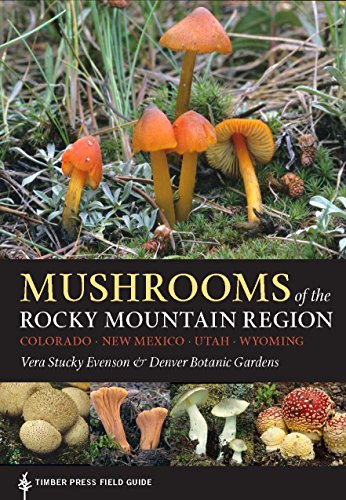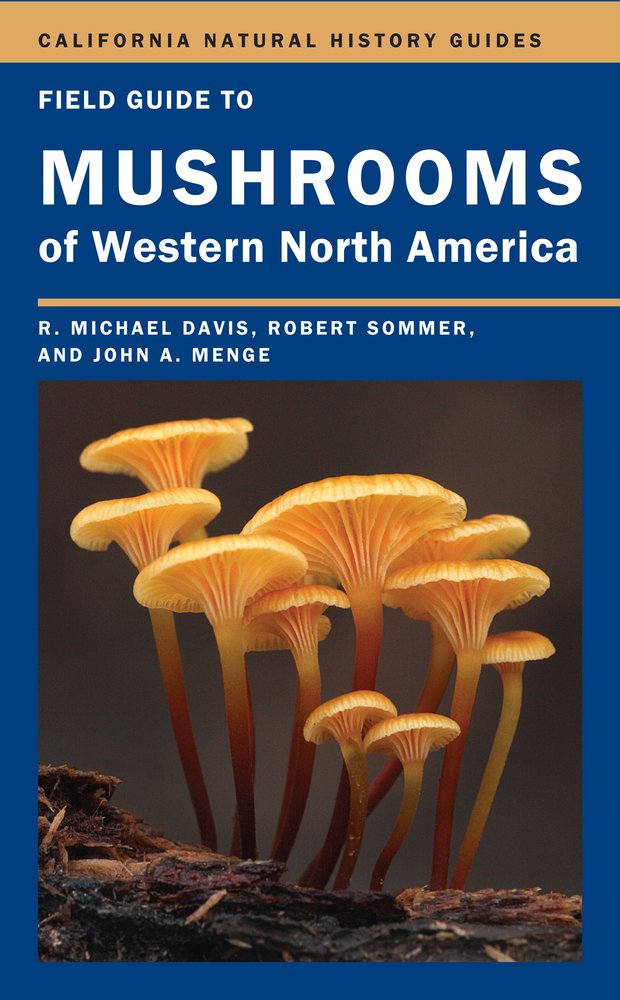Colorado has an amazing diversity of mushrooms, perhaps in part because the extreme topography of the state provides a lot of different kinds of habitat. We’ll just give you a little sampling to pique your interest[i].
Just to be clear—we are not giving you this list (which does not come close to including all that Colorado has to offer) in order to send you out foraging this coming Tuesday. Foraging for the table is a task for experienced mycophiles only. It’s not that all mushrooms are hard to identify, it’s that if you’re a beginner, distinctions that would seem obvious to an experienced eye might pass you by. You also won’t know which variations are important and which are not, so you could think a mushroom is a familiar edible when it’s actually a rare poison.
The point of this article is to motivate you to gain the experience you need.
If you do indeed go Mushroom Hunting make sure you have the proper tools, take a quality knife with you and a basket/bag for your haul!
This list is not meant to be used as a replacement for a field guide, spore prints, an identification app or an in person guide.
Our Recommended Field Guides for Colorado
COVER | TITLE | Header | ||
|---|---|---|---|---|
OUR #1 RATED | ||||
Edible Mushrooms in Colorado
Wild Mushroom (Agaricus sp.)
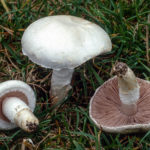
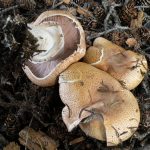
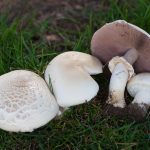
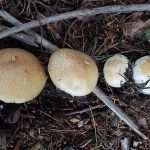
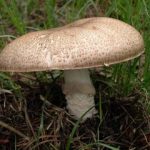
You know those mushrooms you find on pizza and in salads? What’s that species’ name? Depending on age and variety, it might be called white button, crimini, or portobello, but what’s its name overall? Turns out, its name is actually “mushroom.” The word is now commonly applied to many kinds of fungal fruiting bodies, but it started here. So those wild species that most closely resemble cultivated mushroom can properly be called the real wild mushrooms. Colorado has several species.
Meadow mushroom (Agaricus campestris) is probably the closest relative[ii]. A. amicosus[iii] is a high-elevation Coloradao specialty that turns red when cut (though so do several look-alikes). The Horse Mushroom (A. arvensis)[iv] turns yellow when bruised (as do look-alikes) and should be eaten only with caution, as this species can accumulate toxins from the environment. The Woodland Agaricus (A. didymus)[v] is another yellow-stainer and a Colorado specialty. It smells distinctly of almonds. The Rocky-Mountain prince (A. julius)[vi] has only recently been separated from a West-Coast species commonly called “the prince,” so its own common name is still somewhat in flux. Reportedly, it makes excellent eating. It, too, stains yellow with an almond scent.
This whole group is a perfect example of why beginners shouldn’t forage alone. Not only is one yellow-staining agaricus often poisonous[vii], but to a beginner’s eye the differences between the edible agaricus mushrooms and the aptly-named destroying angel are frighteningly easy to miss. Mushroom identification requires experience.
Honey Mushroom (Armillaria sp.)
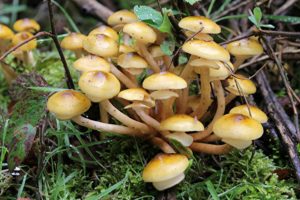
Honey mushroom is named for its color, not its taste, but it is a popular edible. Unfortunately many experts no longer recommend it as it has sickened a few people and nobody yet knows why[viii]. Also, these mushrooms closely resemble a number of seriously toxic species, one of them deadly. But to experienced foragers, honey mushrooms may still appeal.
Note that the honey mushroom group is one that has recently been discovered to contain multiple species that look exactly alike. Which honey species lives in Colorado is thus not clear[ix].
Boletes
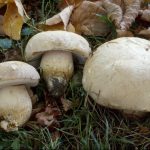
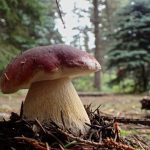

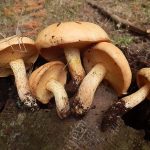
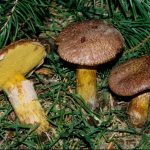
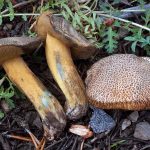
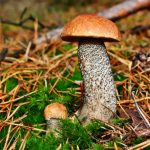
The term “bolete” is a hold-over from the days when all umbrella-shaped fungi with pores rather than gills were lumped in the same giant genus, Boletus. Colorado has some species still in that genus, but also several that have been reassigned to Suillus.
The White King Bolete (Beletus barrowsii)[x] and the Rocky Mountain red king (B. rubriceps)[xi] are both part of a group until recently considered all one species, the king bolete[xii]. You’ll still see a lot of the kings listed by their old scientific name, B. edulis, in a lot of places. In any case, all the kings are considered choice edibles, though they have some look-alikes that may be toxic.
Stubby-stalk (Suillus brevipes)[xiii], Kaibab Weeping Bolete (S. kaibabensis)[xiv], Lake’s bolete (S. lakei)[xv], and Poor-Man’s Slippery Jack (S, tomentosus)[xvi] are all variously-colored, more or less slimy-capped, species considered edible but not choice. Some turn out very nicely when cooked properly, though.
The Aspen Bolete, (Leccinum insigne)[xvii] is part of a group collectively called the scabber-stalks that are traditionally considered edibles in good standing, but have poisoned a few people. It’s not clear why. Improper cooking may be part of the problem. Be careful.
Western Giant Puffball (Calvatia booniana)
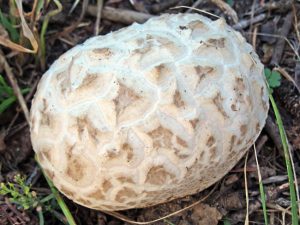
The western giant puffball resembles its eastern cousin except for having a much more textured exterior. It’s huge, sometimes basket-ball sized, meaning it’s often too big to be mixed up with young destroying angels (always a plus)–but it still should be sliced open and inspected before cooking. Puffballs are only edible when young, before the interior starts to discolor. Those who wish to eat giant puffballs should cook or dry them immediately; they go bad as quickly as meat does, once picked, and seldom fit in the refrigerator. Dried puff makes a good powder for use thickening soups.
Milk Caps (Lactarius sp.)
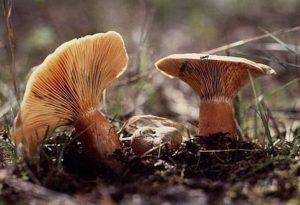
Milk caps are a group of gilled mushrooms notable for the fluid that oozes out when the gills are sliced. The “milk” may indeed be white in some species, while in others it is other, less milk-like, colors. While some are inedible for various reasons, some do make good eating. The Saffron Milky Cap[xviii] is a good example, though it’s unclear which of an unknown number of almost-identical species it actually belongs to. It’s generally listed as Lactarius deliciosus by default, although that is actually a European species[xix]. It does have to be cooked long and slow for best results, but reportedly lives up to the “delicious” name when it is.
Inky Caps

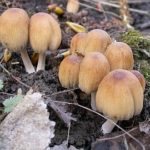
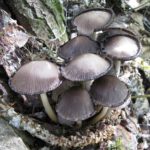
Inky caps are famous for turning to black goo soon after picking (or at maturity, whichever comes first), but if you can cook them before they goo, many make excellent table fare. Though once all lumped into the same genus, it turns out the inky caps are actually scattered across multiple genera in two different, not closely-related species. Some contain a substance that interferes with the breakdown of alcohol, meaning that eating these mushrooms will make drinking alcohol within a day or two extremely unpleasant.
Of Colorado’s species, Shaggy Mane (Coprinus comatus) causes no trouble for drinkers[xx], and is excellent for eaters[xxi]. Glistening Ink Cap, or Mica Ink Cap (Coprinellus micaceus)[xxii] is bland but alright as food and might cause trouble for drinkers[xxiii]. Common Inky Cap (Coprinopsis atramentaria)[xxiv] definitely causes problems for most drinkers, but many consider the mushroom worth a break from alcohol.
Poisonous Mushrooms in Colorado
Please ignore any rules of thumb you may hear about how to tell if a mushroom is toxic. All such rules have exceptions, so following them could get you killed. The only way to know whether a mushroom is poisonous is to figure out what species it is and look it up.
It’s also worth remembering that mushroom safety is not a cut-and-dried thing. There are many species that are poisonous for some people sometimes and safe otherwise. And there are mushrooms that are only very slightly toxic or that have toxins that only produce symptoms after long, repeated exposure. It’s all a bit complicated, and even experts disagree with each other on exactly which mushrooms should be eaten.
The following list is not exhaustive but includes a few of the scarier species[xxv].
Destroying Angel (Amanita bisporigera)
Destroying angel (a name also applied to several other species in other states) is very rare in Colorado, but does occasionally pop up here[xxvi]. People who eat this mushroom sometimes survive if they receive the right medical treatment right away, but this type of poisoning is difficult to diagnose properly, and not all doctors know how to do it. Destroying angels are distinctive, but they are still mistaken for a surprising number of edible mushrooms, including the agarics, the inky caps, and the smaller puffballs.
Deadly Galerina (Galerina marginata)

Deadly Galerina is aptly-named, because, like destroying angel, it contains amotoxin, the poison that takes a day or more to show symptoms and then, right as you think you’re getting better, shuts down your liver or kidneys. The really scary thing is that this species is a nondescript little brown mushroom that often grows right next to several popular edible or “magic” species that are also small, brown, and nondescript.
Never eat a little brown mushroom unless it was cultivated at home or harvested by a true expert. And never make assumptions about mushrooms. If you carefully identify nine out of ten mushrooms in a clump and learn they are all safe to eat, the tenth could still be a Deadly Galerina.
Shield Dapperling (Lepiota clypeolaria)

This is another mushroom whose definition may, in fact, be in flux[xxvii]—but since multiple Lepiotas are known to contain amotoxin[xxviii] and thus may be deadly if eaten, this mushroom is good to avoid even if it proves to be a different Lepiota. The dapperlings generally look like small versions of the parasol mushrooms, several of which are good to eat. That dapperlings are sometimes also called parasols does not help. This one even has the alternate name of “shaggy stalked parasol,” an obvious point of confusion with the edible shaggy parasol.
Fly Agaric (Amanita muscaria)
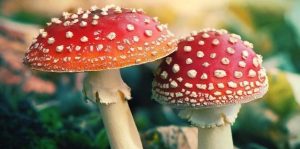
Fly agaric, often referred to by its scientific name, is not usually deadly, but certainly can be. Fortunately, it’s very distinctive-looking and not often eaten by accident. Instead, it is eaten on purpose. This mushroom is psychoactive, and can be used more or less safely for recreational or spiritual purposes if first processed correctly to remove most of its poison (though as its “active ingredient” is not psilocybin, the high is qualitatively different from that from the popular psilocybin mushrooms). The problem is that any mistake in the process could become extremely dangerous.
In the past, we have listed fly agaric in the magic mushroom section. We may do so again. But please be aware that “poisonous” is not a euphemism for “mind-altering” in this case—this mushroom is mind-altering and poisonous.
Panther Cap (Amanita pantherina)
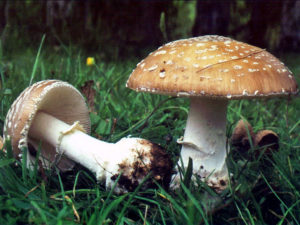
As with several other species, the panther cap[xxix] may be more than one species, and it’s quite possible that the scientific name usually given for it actually applies only to a European species[xxx]. In any case, it is biochemically similar to the fly agaric with its dual role as a seriously toxic, as well as magic, mushroom. Just to complicate things, some forms of the variable mushroom closely resemble one of the few safely edible Amanitas.
False Parasol (Chlorophyllum molybdites)
False parasol is an interesting case. It’s often spoken of as though it were a poisonous look-alike of the edible shaggy parasols. Actually, some of the shaggy parasols are poisonous sometimes, while the false parasol has been eaten without incident on occasion. It may be more accurate to say that the false parasol is simply one end of a continuum from safe to toxic among a group of closely-related and very similar-looking species.
False parasol won’t usually kill you if you eat it, but will make you feel very, very bad. Cases of mistaken identity involving this mushroom are extremely common—it may be the most common cause of mushroom poisoning in the United States.
Sickener (Russula sp.)
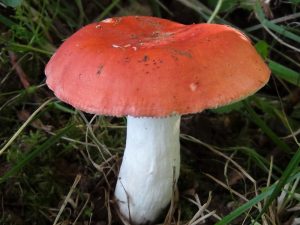
Apparently Russula identification is what mycologists attempt whenever their lives start getting too easy and they don’t have enough stress to deal with. It’s usually fairly clear when a mushroom is a Russula, but which one is it? Who knows. You don’t. We don’t, either. Just do what we do and call all the red ones “sickener” and don’t eat them. As the name implies, they can make you puke.
Magic Mushrooms in Colorado
Possession or use of psilocybin, the “active ingredient” in “magic” mushrooms, is against both Colorado and Federal law, although it has been decriminalized in Denver[xxxi]. Decriminalization doesn’t mean legal, it just means you’re less likely to get charged. We don’t want you to get arrested, OK?
Several psilocybin-containing species do[xxxii] grow wild in the state, but collecting and eating them not only risks arrest but also a highly unpleasant death, since the deadly galerina is a close look-alike of most of them. The rule about only experts collecting mushrooms for consumption applies here, too.
Also, please remember that while psilocybin is a relatively safe way to alter the mind, serious (very rarely, even fatal) reactions can occur. Be careful out there.
Banded Mottlegill (Panaeolus cinctulus)
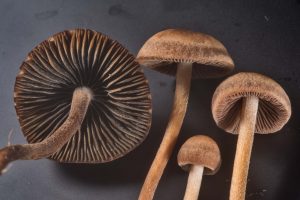
The mottlegills are so called because their spores develop unevenly, resulting in dark mottling on the gills. They range from potently psychoactive to not psychoactive at all. This species occupies the middle of the range. Reportedly, its high is qualitatively similar to that of the psilocybes.
Panaeolus olivaceus
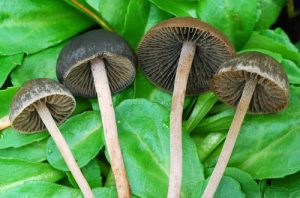
Although the Panaeolus genus contains some of the most potent magic mushrooms around, this little guy isn’t one of those. In fact, some individuals contain no psilocybin at all. Others are weakly psychoactive. People who use P. olivaceus seem to do so more because sampling psychoactive mushrooms has become a hobby, not because they especially want to get high. Such hobbyists must be careful not to confuse this species with its more potent look-alikes, as serious over-dosing could occur.
Gymnopilus sp.
The Gyms are another group with unclear species definitions. Not much information is available on their psychoactive effects, but reportedly, the high differs qualitatively different from that of the more familiar psilocybes.
COVER | TITLE | Header | ||
|---|---|---|---|---|
OUR #1 RATED | ||||
References:
[i] (n.d.). Colorado Mushrooms. Colorado Mushrooms
[ii] (n.d.). Agaricus campestris L.–Field Mushroom. First Nature
[iii] (n.d.). Agaricus amicosus. Colorado Mushrooms
[iv] (n.d.). Agaricus avensis Schaeff.–Horse Mushroom. First Nature
[v] (n.d.). Agaricus dydymus. Colorado Mushrooms
[vi] (n.d.). Agaricus julius. Colorado Mushrooms
[vii] (n.d.). Agaricus xanthodermus Genevs.—Yellow Stainer. First Nature
[viii] (n.d.). Armillaria mellea (Vahl) P. Kumm.—Honey Fungus. First Nature
[ix] Kuo, M. (2017). Armillaria mellea. MushroomExpert
[x] Volk, T. (2004). Boletus barrowsii, Chuck Barrows’ Bolete. Tom’s Fungi
[xi] Aon, O. (20 21). The Rocky Mountain Red, Bolete rubriceps. Forage Colorado
[xii] Kuo. M. (2016). Boletus edulis. MushroomExpert
[xiii] Wood, M., Stevens, F. (n.d.). California Fungi—Suillus brevipes. California Fungi
[xiv] (n.d.). The Bolete Filter: Triage (A Synoptic Key) North American Boletes. WPA Mushroom Club
[xv] Wood, M., Stevens, F. (n.d.). California Fungi—Suillus lakei. California Fungi
[xvi] Wood, M., Stevens, F. (n.d.). California Fungi—Suillus tomentosus. California Fungi
[xvii] (n.d.). Leccinum insigne. Burke Herbarium Image Collection
[xviii] Wood, M., Stevens, F. (n.d.). California Fungi—Lactarius deliciosus. California Fungi
[xix] Kuo, M. (2011). Lactarius “deliciosus” Group. MushroomExpert
[xx] (n.d.). The Inky Cap Mushroom: Can You Safely Eat and Consume Alcohol? Mushroom Huntress
[xxi] (n.d.). Coprinus comatus (O.F. Müll.) Pers.—Shaggy Inkcap. First Nature
[xxii] (n.d.). Coprinellus micaceus (Bull.) Vilgalys, Hopple & Jacq. Johnson—Glistening Inkcap. First Nature
[xxiii] Clarke, D., Crews, C. (2014). Hazards and Diseases. Encyclopedia of Food Safety
[xxiv] (n.d.). Coprinopsis atramentaria (Bull,) Redhead, Vilgalys & Moncalvo—Common Inkcap. First Nature
[xxv] DeGroot, D. (2019). Colorado’s Deadly Mushrooms: 7 Species You Should Not Eat. Our Community Now
[xxvi] Butzer, S. (2018). Mushroom Deadly to Humans, Pets Appears in Yard in Aurora. Denver 7 ABC
[xxvii] Kuo, M. (2015). Lepiota clypeolaria. MushroomExpert
[xxviii] Duffy, T. J. (n.d.). Toxic Fungi of Western North America. MykoWeb: Mushrooms, Fungi, Mycology
[xxix] (n.d.). Amanita pantherina (DC.) P. Kumm—Panthercap. First Nature
[xxx] Kuo, M. (2013). Amanita pantherina. MushroomExpert
[xxxi] (2019). Psilocybin Mushroom Laws in Colorado. Colorado Legal Defense Group
[xxxii] (n.d.). Which Psilocybin Mushroom Grow Wild in My Area? Shroomery



